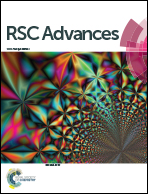Downstream processing of microalgal feedstock for lipid and carbohydrate in a biorefinery concept: a holistic approach for biofuel applications†
Abstract
An integrated microalgal feedstock-based biorefinery approach towards improving overall performance of downstream processing of algal biomass to produce multiple products is necessary to make a good value proposition. The present study thus focuses on the development of an integrated downstream processing strategy for the concomitant extraction of lipid and carbohydrate as feedstocks for potential biofuel applications. A harvesting efficiency of up to 90.6 ± 2.8% and 98.7 ± 2.1% was accomplished for Chlorococcum cells by employing minimal FeCl3 in first the 30 min and 150 min, respectively, as opposed to 55.52 ± 2.2% in 30 min using only its self-flocculation ability. Various physical and chemical pretreatment methods were attempted to maximize the recovery of sugars and lipids, separately and simultaneously. Microalgal lipid was efficiently recovered using cell disruption with bead-beating and chloroform–methanol (2 : 1, v/v) as the extraction solvent. The microalgal carbohydrate recovery and conversion into free fermentable sugars was found to be greater in the case of acid hydrolysis as compared to alkaline hydrolysis. The microalgal biomass, when pretreated separately, gave a total sugar yield of 89.6 ± 3.1% and a total lipid yield of 96.2 ± 2.9%. Therefore, to improve the performance of the process, simultaneous extraction of carbohydrate and lipid was carried out using bead-beating followed by acid treatment. The recoveries of fermentable sugars from the supernatant and that of lipid from pellets were most efficient, with respective yields of nearly 86.5 ± 2.6% and 74.1 ± 1.8%, without any downtime. The extracted lipid was then converted into fatty acid methyl esters (FAME) as a biodiesel product using the standardized acid catalyzed transesterification reaction, resulting in FAME conversion of 94.7 ± 2.5%. The fermentability of the total sugars to bioethanol using S. cerevisiae was studied and a maximum ethanol concentration of 4.1 ± 0.2 g L−1 was obtained. Thus, the study holistically addresses some technological challenges in the downstream processing of microalgal biomass for the efficient recovery of lipid and carbohydrate for the production of biofuels in a biorefinery model for sustainable future development.


 Please wait while we load your content...
Please wait while we load your content...